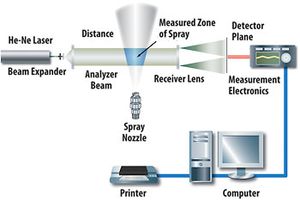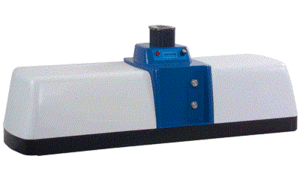Difference between revisions of "Laser Diffraction Analyzers"
(Created page with "Category:Analyzing{{Knoppen}} <noinclude><!------------------------------------------------ * READ THIS FIRST * Only edit this page if you can improve the content. * Imprope...") |
|||
| Line 7: | Line 7: | ||
* Please start editing this page after the /noinclude | * Please start editing this page after the /noinclude | ||
* -------------------------------------------------></noinclude> | * -------------------------------------------------></noinclude> | ||
[[File:Laser diffraction analyzers.jpg|thumb|right|Laser Diffraction Analyzers]] | |||
[[File:Laser diffraction analyzer1.gif|thumb|right|Laser Diffraction Analyzer]] | |||
'''Laser Diffraction Analyzers''' or laser diffraction spectroscopy is a scientific technique which utilizes properties of the diffraction patterns of a laser beam passed through a substance, to measure the size of its particles. Laser diffraction analyzers is based on the theory of Fraunhofer diffraction, which states that the intensity and angle of the light scattered by a particle is directly proportionalto the size of the particle.The substance being examined is passed through the laser, and the diffracted light focused onto a detector which measures the angular distribution of the intensity of the scattered light. | |||
Laser diffraction is a widely used particle sizing technique for materials ranging from hundreds of nanometers up to several millimeters in size. | |||
==Principles== | |||
Laser diffraction measures particle size distributions by measuring the angular variation in intensity of light scattered as a laser beam passes through a dispersed particulate sample. Large particles scatter light at small angles relative to the laser beam and small particles scatter light at large angles. The angular scattering intensity data is then analyzed to calculate the size of the particles responsible for creating the scattering pattern, using the Mie theory of light scattering. The particle size is reported as a volume equivalent sphere diameter. | |||
Latest revision as of 08:55, 16 December 2012
Laser Diffraction Analyzers or laser diffraction spectroscopy is a scientific technique which utilizes properties of the diffraction patterns of a laser beam passed through a substance, to measure the size of its particles. Laser diffraction analyzers is based on the theory of Fraunhofer diffraction, which states that the intensity and angle of the light scattered by a particle is directly proportionalto the size of the particle.The substance being examined is passed through the laser, and the diffracted light focused onto a detector which measures the angular distribution of the intensity of the scattered light.
Laser diffraction is a widely used particle sizing technique for materials ranging from hundreds of nanometers up to several millimeters in size.
Principles
Laser diffraction measures particle size distributions by measuring the angular variation in intensity of light scattered as a laser beam passes through a dispersed particulate sample. Large particles scatter light at small angles relative to the laser beam and small particles scatter light at large angles. The angular scattering intensity data is then analyzed to calculate the size of the particles responsible for creating the scattering pattern, using the Mie theory of light scattering. The particle size is reported as a volume equivalent sphere diameter.

